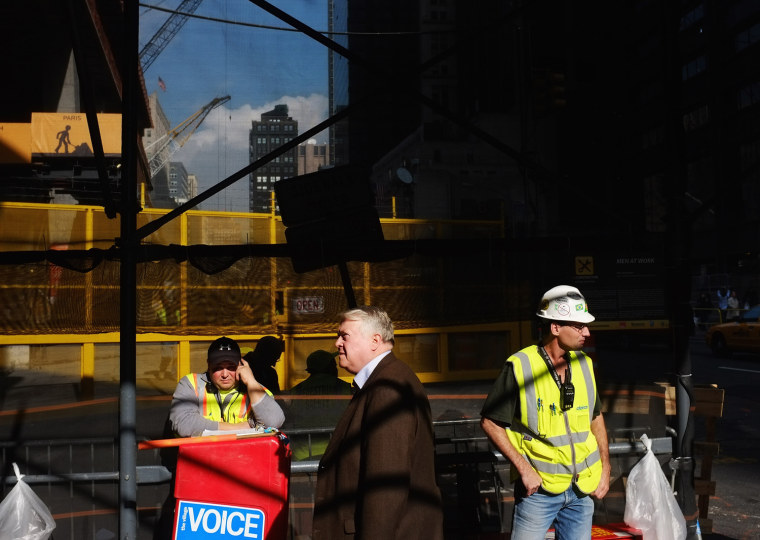In a city still packing a wicked-hard edge, an old maxim lives on: “Boston is about sports, politics and revenge.” From the clout of its labor unions to the grit of its Red Sox, Beantown remains synonymous with working class.
And the locals like it that way.
“Whatever your ethnic tribe, race or class, people here embrace the notion that Boston is a tough town. It has a certain romanticism,” said Thomas Whalen, associate professor of social sciences at Boston University. “You hear it when the (Boston) Celtics meet the (Los Angles) Lakers (in the NBA). Boston revels in the fact that we’re not like the people in ‘La La Land,’ that our team is blue collar.”
But the professor sees the irony in that brawny civic pride. With an economic base bolstered by medical hubs, biotech companies and universities, today's Boston owns a distinctly white-collar look. Los Angeles, conversely, is a working-class epicenter: its 362,700 manufacturing jobs lead all other cities, according to Michael Shires, associate professor of public policy at Pepperdine University in Malibu, Calif.
As factory jobs continue to vanish, however, and the tech sector surges, many historically industrial towns are fading from blue collar to white collar — or, maybe more appropriately, to no collar — while scattered municipalities with seemingly white-collar auras are quietly clinging to working-class values.
Consider San Jose, Calif., home to eBay and Cisco Systems, a dot-com and Silicon Valley powerhouse. Yet 22.6 percent of that city’s work force is composed of blue-collar jobs: production, transportation, construction, installation and maintenance, according to U.S. Census figures. That means San Jose possesses a higher share of manual laborers than two cities long known for their trains and smokestacks: Philadelphia (21.8 percent) and Pittsburgh (16.5 percent).
"It’s possible these traditional collar-labels, crafted in the East Coast/Midwest industrial economy, don’t apply anymore," said Kim Walesh, director of economic development for San Jose. "Generally, we don’t talk in terms of ‘collars’ around here — with business casual in vogue, very few people in Silicon Valley wear white collars anymore.
"More seriously, San Jose has the nation’s second-highest concentration of advanced manufacturing activity," Walesh added. "Yet, this is not your grandfather’s factory floor. The blue-collar production workers of the past are skilled technicians in shop-coats or polo shirts helping engineers figure out how to actually build the next innovative product."
At the same time, some Rust Belt regulars retain their blue-collar roots amid the shifting job tides. In Cleveland, 30.7 percent of the work force is made up of people in manual-labor trades; in Detroit that share is 29.72 percent, Census stats show.
And La La Land? Built largely on the city's contribution to silver screens, Los Angeles can still claim a healthy dose of blue-collar status, though L.A.'s production jobs have dropped by nearly half from the more than 700,000 it possessed at the height of the Cold War, Shires said.
"Aerospace still continues strong in the region that gave us the space shuttle and the B-2 bomber and will continue to fare well in the era of private space and drones," Shires said. "Los Angeles' identity, however has just been driven by its glitzier and higher-profile successes in entertainment."
Of course, no major city is all executive class or all working class. But some cities tilt more definitively white than blue. Based on the same U.S. Census data sets, Seattle’s tech-heavy work force (Zillow and Amazon, with Microsoft headquartered in nearby Redmond, Wash.) is composed of just 12.57 percent of people who earn a paycheck via manual labor. In Boston that rate is 14.7 percent, and in New York City, rife with financial giants (Goldman Sachs, Citigroup, JPMorgan Chase), it’s 19.6 percent.
"This used to be a city where middle-class people could find reasonable housing and good schooling, but it’s increasingly becoming a place where that’s impossible," said Ann Morning, associate professor of sociology at New York University. "Instead, people talk about super-wealthy elites from around the world coming and buying the mega-luxury apartments then having to share the city with all the service people who make those luxury accommodations possible."
At the end of World War II, 41 percent of the Big Apple's work force included craftsmen, laborers, foremen and other blue-collar types, according to the book "Working-Class New York."
"Today, it's increasingly hard for elementary school teachers or librarians or firemen or policemen to live (in Manhattan). You hear people talk about that here. The other boroughs are the holding community, the bedroom communities for the people who do service work in Manhattan," Morning said.
How about college sociology professors?
"Yes, I live in Manhattan, and in fact was born here," Morning said, adding with a smile: "It is only possible, though, because my employer subsidizes my housing."
